From Key Role to Core Infrastructure: Platforms as AI Enablers in Hospitality Management
Abstract
1. Introduction
2. Background and Literature Review
2.1. Digital Platforms and Smart Tourism
2.2. Maintenance Strategies in Luxury Hospitality
- corrective maintenance (run-to-failure) Reactive interventions conducted in response to asset failures. These may be planned or unplanned and are generally not preceded by preventive measures;
- preventive maintenance: Scheduled interventions performed regardless of the actual condition of the asset, aimed at reducing the probability of failure;
- condition-Based Maintenance (CBM): Maintenance actions triggered by real-time monitoring of asset condition, based on parameter thresholds. This approach optimizes resource utilization but necessitates investment in monitoring infrastructure and data analytics.
- Predictive maintenance: integrates real-time data and advanced algorithms to estimate the Remaining Useful Life (RUL) of components and schedule interventions before failures occur. Predictive maintenance encompasses anomaly detection, diagnostics (identifying root causes), and prognostics (estimating RUL). Its effectiveness depends on high-quality monitoring and reliable data analytics, often utilizing models such as the P-F (Potential Failure–Functional Failure) curve to optimize intervention timing.
- Prescriptive Maintenance: extends predictive approaches by recommending not only when to intervene but also how to act and which resources to allocate.
2.3. Reinforcement Learning for Prescriptive Maintenance
3. Methodological Framework
3.1. Application Scenario and Objectives
- daily revenue earned when a confirmed guest occupies an available room;
- preventive maintenance expenditure that restores reliability without upsetting future bookings;
- corrective maintenance expenditure and reputational loss caused by unexpected breakdowns that displace guests or lower perceived quality.
3.2. Problem Formalization
3.3. Constraint Handling
3.4. Optimization Algorithm
4. Experimental Campaign
4.1. Environment Parameterization
4.2. Experimental Setup
- Key technical features include the following:
- StateRepresentation The agent observes a flattened vector constructed as the concatenation of for each room and the global variable . The observation is implemented as a Box array with bounds specified for each variable according to environment parameters. Internal environment variables (timers, booking schedules, pending requests) are updated deterministically but remain hidden from the agent.
- Action Representation: The action space is an N-dimensional MultiBinary, with action masking enforced at each step via an explicit action mask. Infeasible actions are masked before sampling by the agent.
- Transition Simulation: Environment transitions (aging, breakdowns, bookings, maintenance, resource updates) are updated room by room at each time step, with stochastic events (breakdown, booking arrivals) sampled from the relevant distributions. The booking process uses a Poisson arrival rate with fixed mean.
4.3. Training and Evaluation
- learning curves: The evolution of mean and standard deviation of cumulative reward is monitored over training epochs on fixed-seed validation environments. These curves are automatically logged and visualized via TensorBoard and custom plotting utilities, enabling direct comparison across different settings and policies.
- State heatmaps For selected evaluation episodes and seeds, custom heatmaps are generated to visualize the temporal evolution of each room’s operational state. Each cell encodes the state (available, occupied, preventive maintenance, corrective maintenance, breakdown with or without guest) using a dedicated color map. This enables rapid, qualitative inspection of emergent maintenance strategies and identification of operational bottlenecks, such as clustered breakdowns or suboptimal intervention timing.
4.4. Hyperparameter Tuning
- Entropy coefficien: controls the exploration–exploitation tradeoff.
- Learning rate: determines the optimization step size.
- Network architecture: defines the depth and width of the policy MLP.
- Maintenance resources: maximum number of simultaneous maintenance interventions.
5. Results
5.1. Cyclic Preventive Policy—Infinite Capacity
5.2. Optimal Preventive Policy—Infinite Capacity
5.3. Optimal Preventive Policy—Finite Capacity (Favorable Case)
5.4. Optimal Preventive Policy—Finite Capacity (Unfavorable Case)
6. Conclusions
Author Contributions
Funding
Data Availability Statement
Conflicts of Interest
Abbreviations
| AI | Artificial Intelligence |
| DT | Digital Twin |
| IoT | Internet of Things |
| MDP | Markov Decision Process |
| MLP | Multi Layer Perceptron |
| PPO | Proximal Policy Optimization |
| RL | Reinforcement Learning |
Appendix A. MDP Formulation
Appendix A.1. State Space
- counts the days since its last maintenance intervention.
- is the countdown in days to the next confirmed guest arrival; indicates that the room is occupied on day t.
- denotes the operational mode of the room: 0 for available, 1 for under maintenance (either preventive or corrective), and 2 for in a breakdown state.
- records the days remaining until the next cyclic maintenance service; indicates that the maintenance service is currently due.
- : a timer for room i indicating the remaining duration in days until the current maintenance intervention (preventive or corrective) is completed. This timer is active when .
- : a timer for room i specifying the number of days remaining until the current guest checks out. This variable is relevant when the room is occupied (i.e., ).
- : an ordered set of confirmed future bookings assigned to room i. Each booking is typically represented by a tuple (check-in day, check-out day). The variables and can be derived from this set and the current day t.
- : the set of pending booking requests that have been generated (e.g., through a daily arrival process) but have not yet been assigned to any room.
Appendix A.2. Action Space
- For each room i:
- signifies a proactive decision by the agent to attempt to initiate a maintenance service on room i starting the next day.
- –
- If room i is currently available () and not yet due for scheduled preventive maintenance (), this action represents a request for early or opportunistic preventive maintenance.
- –
- If room i is in breakdown state (), this action represents a request for corrective maintenance.
- signifies that the agent chooses not to initiate a new maintenance service for room i. The room’s state will then evolve based on other factors: it may continue its normal operation, potentially experience a stochastic breakdown, or undergo a forced maintenance if system rules dictate (e.g., a preventive maintenance becoming critically overdue, as detailed in Appendix A.3).
- Resource availability: There must be at least one maintenance resource unit available (i.e., ). Both preventive and corrective maintenance tasks require one unit of resource for their entire duration. The total number of available resources per day is fixed.
- Room occupancy: To initiate preventive maintenance on an available room (), the room must not be occupied by a guest on the day the maintenance would commence (i.e., ). This constraint does not apply to corrective maintenance tasks, as rooms in breakdown state are already unavailable for guests.
Appendix A.3. Transition Dynamics
- Room Aging: for a room i in available mode () where no maintenance is initiated ():
- –
- Its age increases by one day: .
- –
- A breakdown may occur with probability , where k and are the Weibull shape and scale parameters. If a breakdown occurs, the room’s state transitions to breakdown: . Each breakdown is assumed to be of a single generic type, and the repair procedure does not differentiate between failure modes.
- –
- If no breakdown occurs and the room is not imminently scheduled for maintenance (), it is considered available. If it is occupied on day t, indicated by , it earns the daily revenue R.
- Initiating Preventive Maintenance: for a room i in available mode () where a preventive maintenance action is chosen (), and this action is feasible:
- –
- The room state transitions to maintenance: .
- –
- The maintenance duration timer is set: .
- –
- The age counter is frozen: .
- –
- The preventive maintenance cycle timer is frozen during maintenance and will be reset upon completion: .
- –
- Any conflicting guest bookings for the duration of the maintenance, as recorded in its booking set , are cancelled, and is updated accordingly.
- –
- The count of available maintenance resources is decremented: .
- Initiating Corrective Maintenance: for a room i in a breakdown state () where a corrective maintenance action is chosen (), and this action is feasible:
- –
- The room state transitions to maintenance: .
- –
- The maintenance duration timer is set: , where .
- –
- The age counter is frozen: .
- –
- The preventive maintenance cycle timer is frozen during maintenance and will be reset upon completion: .
- –
- There is no need to check for conflicting bookings because a room in breakdown cannot be booked.
- –
- The count of available maintenance resources is decremented: .
- Ongoing Maintenance: for a room i already undergoing maintenance ():
- –
- The remaining maintenance duration timer decrements by one day: .
- –
- If the timer reaches 0:
- ∗
- The room returns to available mode: .
- ∗
- Its age is reset: .
- ∗
- The preventive maintenance cycle timer is reset to its nominal interval: .
- ∗
- The maintenance resource unit it occupied becomes available: .
- –
- Otherwise, the room remains in maintenance () and its age and preventive maintenance cycle timer remain frozen (, ).
- Unmanaged Breakdowns: for a room i in a breakdown state () where a maintenance action () is not chosen or feasible:
- –
- The room remains in the breakdown state: .
- –
- Its age and preventive maintenance cycle timer remain frozen: , .
- Updates at end of day: for rooms not involved in maintenance activities (i.e., ) that would otherwise reset or freeze them, relevant timers are decremented. Specifically:
- –
- If room i is vacant (), its vacancy duration decrements: .
- –
- If room i is occupied (), its guest checkout timer (which is derived from the booking set ) effectively decrements as one day passes. Once indicates that the guest has checked out (i.e., it reaches zero relative to the start of the next day), this change is noted, and the room may become available. The definitive determination of its status (and if immediately reoccupied) for day occurs after all end-of-day processes, based on the comprehensively updated booking set .
- –
- For rooms in available mode () and not undergoing preventive maintenance initiation, the preventive maintenance cycle timer decrements: .
- Booking Process:
- –
- New reservation requests arrive according to a Poisson process with intensity .
- –
- Each request is characterized by a stochastic lead time L (e.g., drawn from a geometric distribution with parameter and a stay length S (e.g., drawn from a truncated normal distribution ).
- –
- Pending requests (newly arrived and previously unassigned) are assigned to available rooms () based on a defined heuristic (e.g., prioritizing rooms that will be vacant longest, i.e., largest , or are furthest from their next preventive maintenance, i.e., largest ). This process updates the set of confirmed future bookings for the assigned rooms. Subsequently, the occupancy status and guest checkout timer are derived from this updated .
Appendix A.4. Reward Function
Appendix A.5. Objective
Appendix A.6. Policy Parametrization
References
- Zeqiri, A. From Traditional to Digital: The Evolution of Business Models in Hospitality Through Platforms. Platforms 2024, 2, 221–233. [Google Scholar] [CrossRef]
- Ceylan, E.N.; Tülbentçi, T. Facility operation and maintenance management model for small and medium-sized hotels in Turkey. Int. J. Adv. Appl. Sci. 2020, 7, 1–18. [Google Scholar] [CrossRef]
- Gajić, T.; Petrović, M.D.; Pešić, A.M.; Conić, M.; Gligorijević, N. Innovative Approaches in Hotel Management: Integrating Artificial Intelligence (AI) and the Internet of Things (IoT) to Enhance Operational Efficiency and Sustainability. Sustainability 2024, 16, 7279. [Google Scholar] [CrossRef]
- Turnšek, M.; Radivojević, V. Platformization in Tourism: Typology of Business Models, Evolution of Market Concentration and European Regulation Responses. Platforms 2025, 3, 1. [Google Scholar] [CrossRef]
- Beverungen, D.; Kundisch, D.; Wünderlich, N.V. Transforming into a platform provider: Strategic options for industrial smart service providers. J. Serv. Manag. 2020, 32, 507–532. [Google Scholar] [CrossRef]
- Osadare, O.O.; Akande, O.N.; Soladoye, A.A.; Sobowale, P.O. Smart Hospitality: Leveraging Technological Advances to Enhance Customer Satisfaction. FUOYE J. Eng. Technol. 2024, 9, 553–557. [Google Scholar] [CrossRef]
- Müller, J.M.; Buliga, O.; Voigt, K. Fortune favors the prepared: How SMEs approach business model innovations in Industry 4.0. Technol. Forecast. Soc. Change 2018, 132, 2–17. [Google Scholar] [CrossRef]
- Frank, A.G.; De Sousa Mendes, G.H.; Ayala, N.F.; Ghezzi, A. Servitization and Industry 4.0 convergence in the digital transformation of product firms: A business model innovation perspective. Technol. Forecast. Soc. Change 2019, 141, 341–351. [Google Scholar] [CrossRef]
- Cozzolino, A.; Corbo, L.; Aversa, P. Digital platform-based ecosystems: The evolution of collaboration and competition between incumbent producers and entrant platforms. J. Bus. Res. 2021, 126, 385–400. [Google Scholar] [CrossRef]
- Madanguli, A.; Parida, V.; Sjödin, D.; Oghazi, P. Literature review on industrial digital platforms: A business model perspective and suggestions for future research. Technol. Forecast. Soc. Change 2023, 194, 122606. [Google Scholar] [CrossRef]
- Ancillai, C.; Sabatini, A.; Gatti, M.; Perna, A. Digital technology and business model innovation: A systematic literature review and future research agenda. Technol. Forecast. Soc. Change 2023, 188, 122307. [Google Scholar] [CrossRef]
- Ku, E.C.S.; Chen, C.D. Artificial intelligence innovation of tourism businesses: From satisfied tourists to continued service usage intention. Int. J. Inf. Manag. 2024, 76, 102757. [Google Scholar] [CrossRef]
- Cranmer, E.E.; Urquhart, C.; tom Dieck, M.C.; Jung, T. Developing augmented reality business models for SMEs in tourism. Inf. Manag. 2021, 58, 103551. [Google Scholar] [CrossRef]
- Ben Youssef, A.; Redžepagić, S.; Zeqiri, A. The key changes to the hospitality business model under COVID-19. Strateg. Manag. 2022, 27, 55–64. [Google Scholar]
- Breier, M.; Kallmuenzer, A.; Clauß, T.; Gast, J.; Kraus, S.; Tiberius, V. The role of business model innovation in the hospitality industry during the COVID-19 crisis. Int. J. Hosp. Manag. 2021, 92, 102723. [Google Scholar] [CrossRef]
- Zahidi, F.; Kaluvilla, B.B.; Mulla, T. Embracing the new era: Artificial intelligence and its multifaceted impact on the hospitality industry. J. Open Innov. Technol. Mark. Complex. 2024, 10, 100390. [Google Scholar] [CrossRef]
- Huang, A.; Chao, Y.; de la Mora Velasco, E.; Bilgihan, A.; Wei, W. When artificial intelligence meets the hospitality and tourism industry: An assessment framework to inform theory and management. J. Hosp. Tour. Insights 2021, 5, 228–248. [Google Scholar] [CrossRef]
- Florido-Benítez, L. The Use of Digital Twins to Address Smart Tourist Destinations’ Future Challenges. Platforms 2024, 2, 234–254. [Google Scholar] [CrossRef]
- Ghazi, K.M. Hotel maintenance management practices. J. Hotel Bus. Manag. 2016, 5, 136. [Google Scholar] [CrossRef]
- Chan, K.T.; Lee, R.H.K.; Burnett, J. Maintenance performance: A case study of hospitality engineering systems. Facilities 2001, 19, 494–504. [Google Scholar] [CrossRef]
- Longart, P. Understanding hotel maintenance management. J. Qual. Assur. Hosp. Tour. 2019, 21, 267–296. [Google Scholar] [CrossRef]
- Ihsan, B.; Alshibani, A. Factors affecting operation and maintenance cost of hotels. Prop. Manag. 2018, 36, 296–313. [Google Scholar] [CrossRef]
- Lai, J.H.K. An analysis of maintenance demand, manpower, and performance of hotel engineering facilities. J. Hosp. Tour. Res. 2013, 37, 426–444. [Google Scholar] [CrossRef]
- Sutton, R.S.; Barto, A.G. Reinforcement Learning: An Introduction, 2nd ed.; MIT Press: Cambridge, MA, USA, 2020. [Google Scholar]
- Schulman, J.; Wolski, F.; Dhariwal, P.; Radford, A.; Klimov, O. Proximal Policy Optimization Algorithms. arXiv 2017, arXiv:1707.06347. [Google Scholar] [CrossRef]
- Ruiz Rodríguez, M.L.; Kubler, S.; de Giorgio, A.; Cordy, M.; Robert, J.; Le Traon, Y. Multi-Agent Deep Reinforcement Learning-Based Predictive Maintenance on Parallel Machines. Robot. Comput.-Integr. Manuf. 2022, 78, 102406. [Google Scholar] [CrossRef]
- Nguyen, V.T.; Do, P.; Voisin, A. Artificial-Intelligence-Based Maintenance Scheduling for Complex Systems with Multiple Dependencies. PHM Soc. Eur. Conf. 2022, 7, 586–589. [Google Scholar] [CrossRef]
- Ghaly, A.; Amin, M.; Tedla, T.; Hosny, O.; Elbehairy, H. Coastal Hotels and Resorts: Infrastructure Asset Management System Model. In Proceedings of the Canadian Society of Civil Engineering Annual Conference 2022 (CSCE 2022), Whistler, BC, Canada, 25–28 May 2022; Gupta, R., Sun, M., Brzev, S., Alam, M.S., Wai Ng, K.T., Li, J., El Damatty, A., Lim, C., Eds.; Lecture Notes in Civil Engineering. Springer: Cham, Switzerland, 2023; Volume 363. [Google Scholar] [CrossRef]
- Ruiz-Rodríguez, M.L.; Kubler, S.; Robert, J.; Le Traon, Y. Dynamic Maintenance Scheduling Approach under Uncertainty: Comparison between Reinforcement Learning, Genetic-Algorithm Simheuristic and Dispatching Rules. Expert Syst. Appl. 2024, 248, 123404. [Google Scholar] [CrossRef]
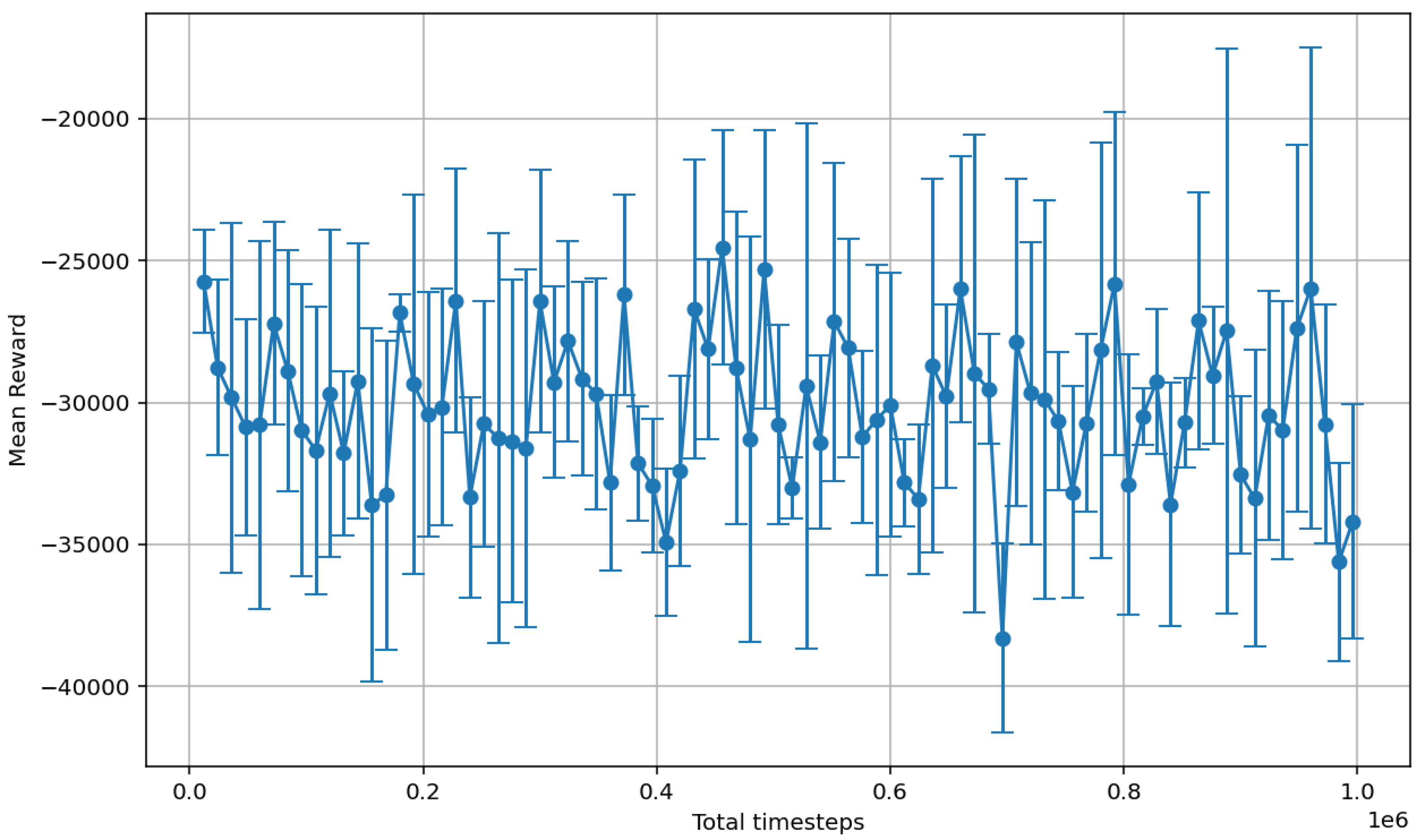
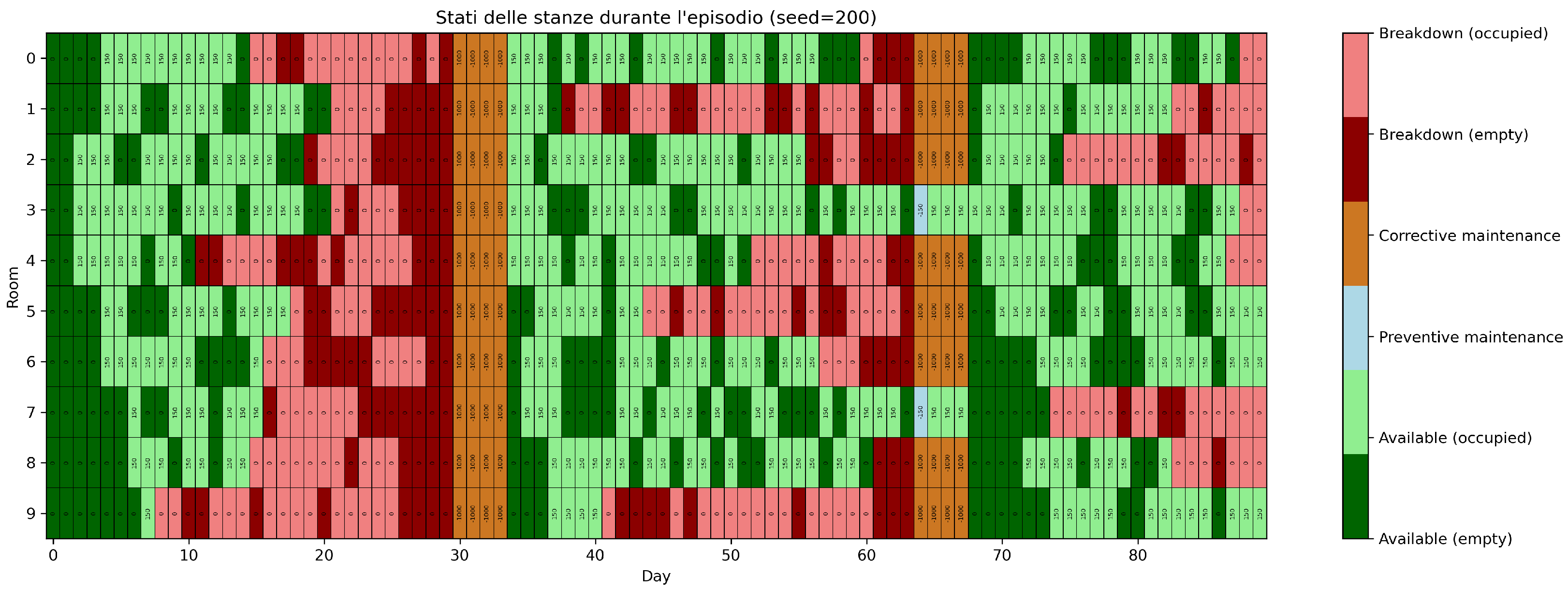
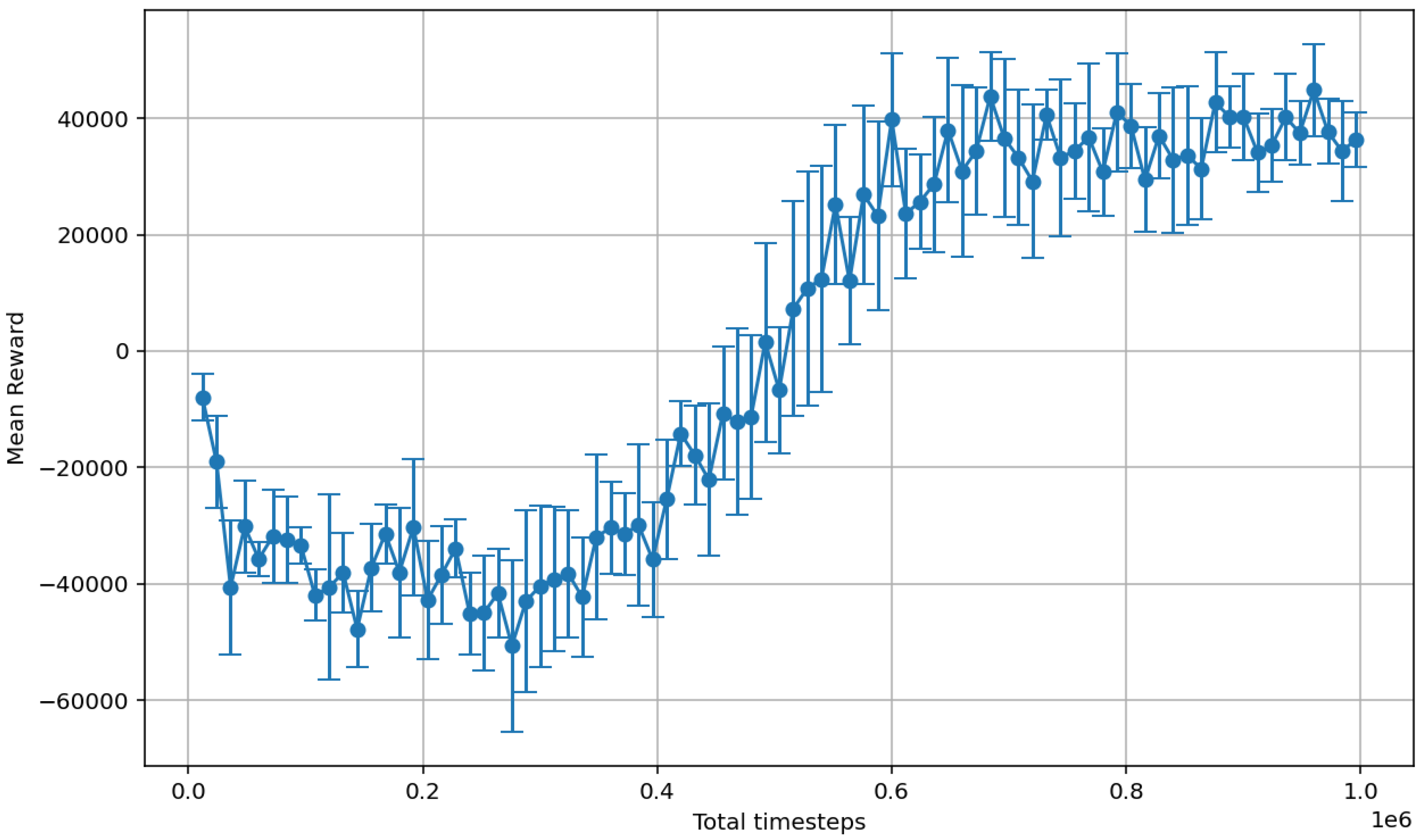


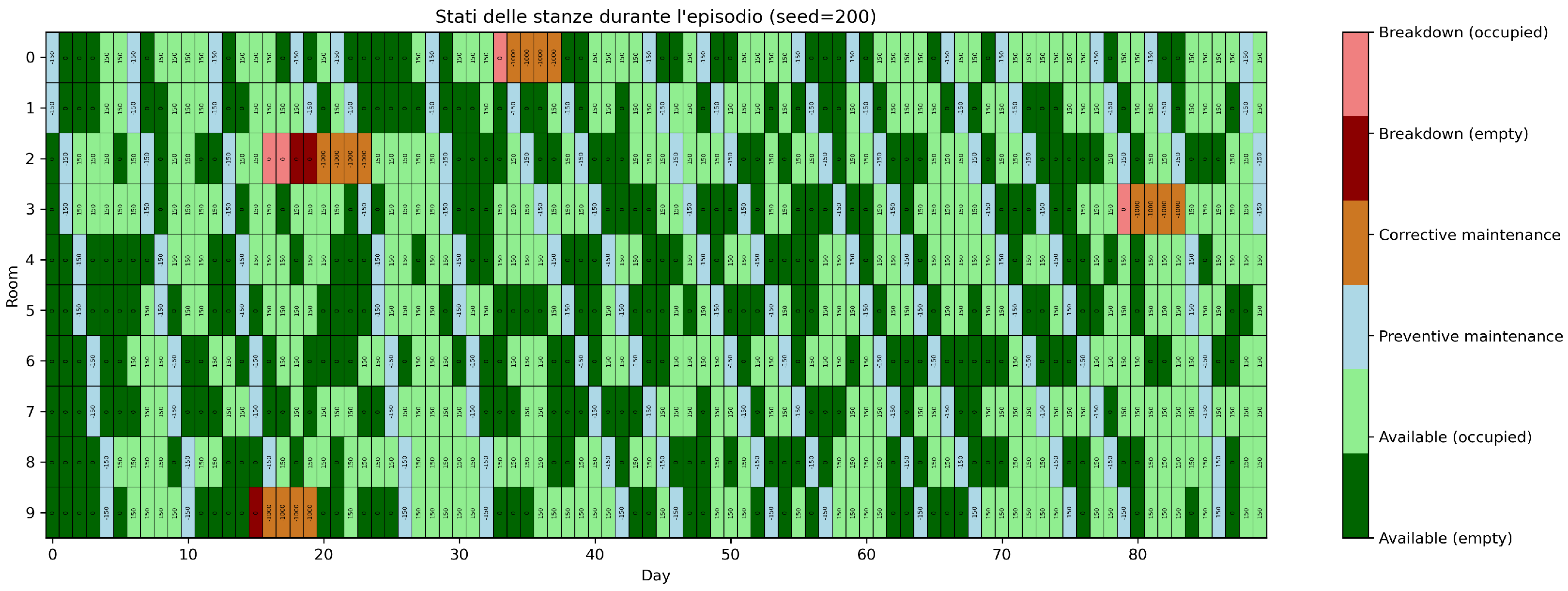
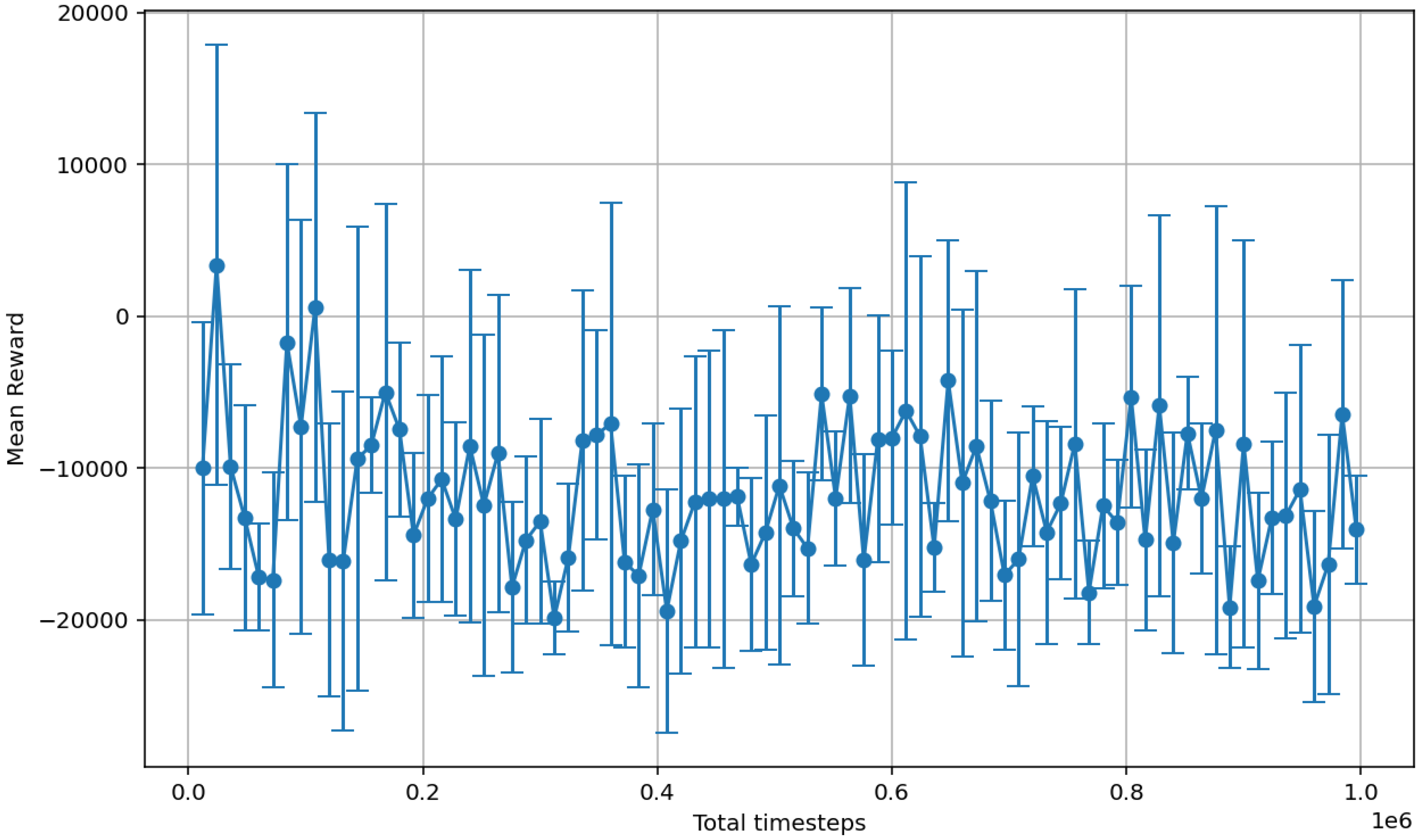
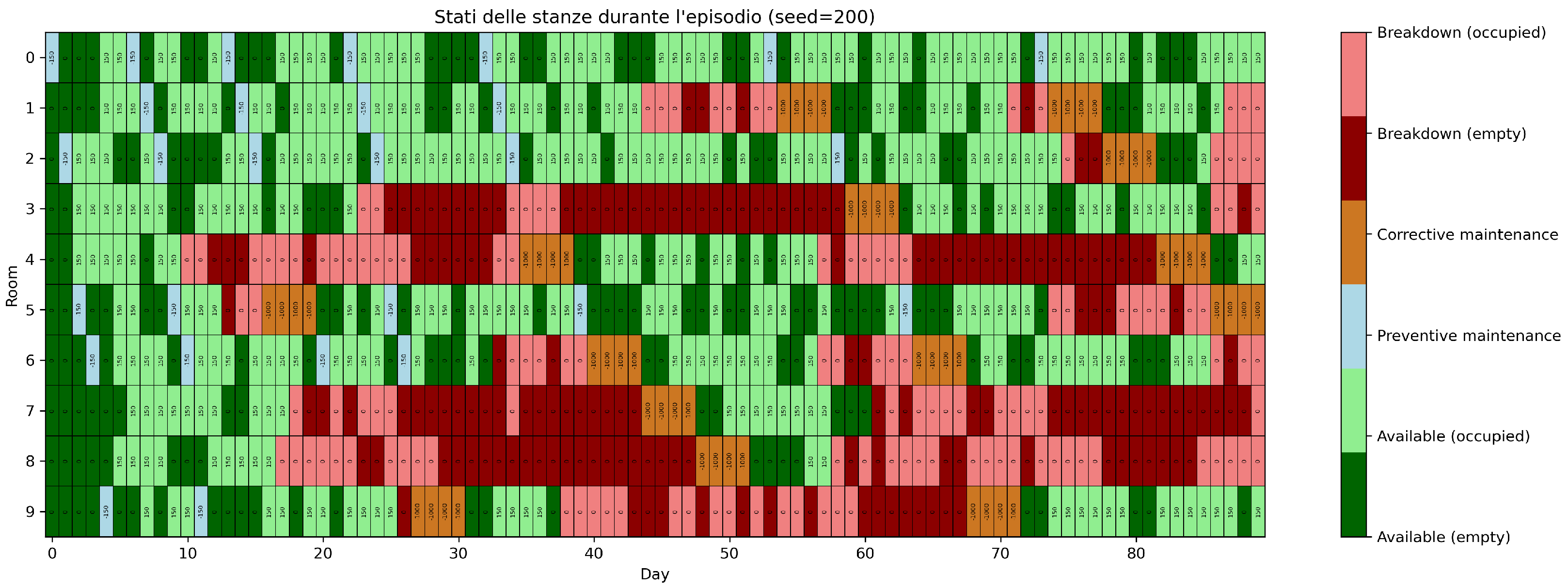
| Parameter | Description | Value |
|---|---|---|
| N | Number of rooms | 10 |
| T | Episode duration | 90 days |
| Preventive maintenance duration | 1 day | |
| Corrective maintenance duration | 4 days | |
| (reset) | Preventive maintenance cycle | 30 days |
| R | Daily revenue per occupied room | EUR 150 |
| Preventive maintenance cost | EUR 150 | |
| Corrective maintenance cost | EUR 1000 | |
| Probability for booking lead time (geometric) | ||
| Booking rate (Poisson mean) | 3 per day | |
| Average stay duration (Poisson mean) | 3 days | |
| k, | Weibull shape and scale (failure time) | , |
| Number of maintenance resources | from 1 to 10 |
Disclaimer/Publisher’s Note: The statements, opinions and data contained in all publications are solely those of the individual author(s) and contributor(s) and not of MDPI and/or the editor(s). MDPI and/or the editor(s) disclaim responsibility for any injury to people or property resulting from any ideas, methods, instructions or products referred to in the content. |
© 2025 by the authors. Licensee MDPI, Basel, Switzerland. This article is an open access article distributed under the terms and conditions of the Creative Commons Attribution (CC BY) license (https://creativecommons.org/licenses/by/4.0/).
Share and Cite
Grieco, A.; Caricato, P.; Margiotta, P. From Key Role to Core Infrastructure: Platforms as AI Enablers in Hospitality Management. Platforms 2025, 3, 16. https://doi.org/10.3390/platforms3030016
Grieco A, Caricato P, Margiotta P. From Key Role to Core Infrastructure: Platforms as AI Enablers in Hospitality Management. Platforms. 2025; 3(3):16. https://doi.org/10.3390/platforms3030016
Chicago/Turabian StyleGrieco, Antonio, Pierpaolo Caricato, and Paolo Margiotta. 2025. "From Key Role to Core Infrastructure: Platforms as AI Enablers in Hospitality Management" Platforms 3, no. 3: 16. https://doi.org/10.3390/platforms3030016
APA StyleGrieco, A., Caricato, P., & Margiotta, P. (2025). From Key Role to Core Infrastructure: Platforms as AI Enablers in Hospitality Management. Platforms, 3(3), 16. https://doi.org/10.3390/platforms3030016






